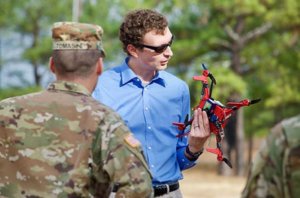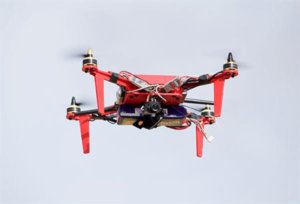






 Engineers at the U.S. Army Research Laboratory have performed flight tests on 3D printed drones that could be used to assist soldiers. Using mission planning software, the engineers can fabricate and deliver a mission-specific 3D printed UAV in just 24 hours.
Engineers at the U.S. Army Research Laboratory have performed flight tests on 3D printed drones that could be used to assist soldiers. Using mission planning software, the engineers can fabricate and deliver a mission-specific 3D printed UAV in just 24 hours.
The U.S. Army Research Laboratory (ARL), part of the U.S. Army Research, Development and Engineering Command, is responsible for carrying out innovative research that can provide the Army with a competitive edge over enemy forces. In its efforts to assist the Army using modern resources, ARL has recently been making use of two of this decade’s most iconic technologies—3D printing and unmanned aerial vehicles (UAVs)—to create mission-specific 3D printed drones that can be automatically configured and optimized for any task.
According to ARL researchers, these 3D printed drones could have many uses within the Army, helping soldiers on missions that require aerial surveillance, communication, or delivery. And thanks to special mission planning software, these 3D printed UAVs can be designed, flight tested, and delivered over a period of just 24 hours.
“We’ve created a process for converting soldier mission needs into a 3D printed On-Demand Small Unmanned Aircraft System, or ODSUAS, as we've been calling it,” said Eric Spero, team leader and project manager.
Over the first three days of December, ARL engineers were invited to Fort Benning, Georgia, to demonstrate the adaptable 3D printed drones at the Army Expeditionary Warrior Experiments, or AEWE. Determined to showcase the drones to their best ability on “game day,” the engineers launched the drones and had them flying up to 55 miles per hour, impressing many military personnel in attendance.
 The ARL team subsequently explained to Army chiefs about how the 3D printed flying vehicles could be created in just a day—a fact that wowed the top brass as much as the drones themselves did. “We thought they're not going to think that's fast enough, but, actually it was the opposite,” Spero said. “The timeline of 24 hours to receive a mission-custom unmanned aircraft system fits right in line with the way they plan and execute their missions.”
The ARL team subsequently explained to Army chiefs about how the 3D printed flying vehicles could be created in just a day—a fact that wowed the top brass as much as the drones themselves did. “We thought they're not going to think that's fast enough, but, actually it was the opposite,” Spero said. “The timeline of 24 hours to receive a mission-custom unmanned aircraft system fits right in line with the way they plan and execute their missions.”
The engineers spent several hours flight testing and verifying the 3D printed drones prior to AEWE, but also received lots of key feedback during the event itself. Based on comments from Army leaders, the ARL team will now focus on reducing the noise of the 3D printed UAV, increasing its standoff distance, increasing its payload capacity, and improving its agility.
Although 3D printing is being used to develop a range of technologies at ARL, the focus at present is on perfecting the 3D printed Army drones, which can either fly autonomously or be operated via remote control. Although mostly 3D printed, the drones also contain off-the-shelf parts, such as motors and propellers.
“Drones or quadcopters are really getting big right now—I mean, in particular, just the commercial and hobby markets have shown what can be done with a small amount of money,” said John Gerdes, an engineer on the project. “Additive manufacturing or 3D printing has become huge and everybody knows all the great things that can be done with 3D printers. So we figured let's assemble these two new technologies and provide a solution to soldiers that need something right now and don't want to wait for it.”
ARL has been collaborating with Georgia Tech's Aerospace Systems Design Lab during its efforts to develop the 3D printed drones.
Prepared on the basis of information from 3ders.org